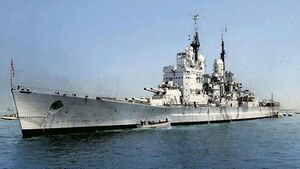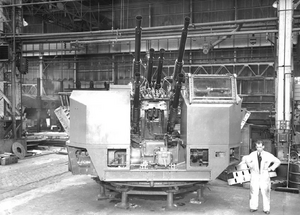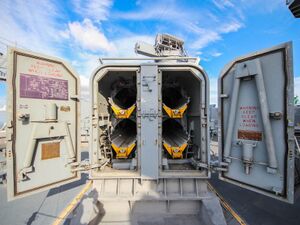Halvard I Class: Difference between revisions
No edit summary |
|||
| Line 151: | Line 151: | ||
!Fate | !Fate | ||
|- | |- | ||
| 023 || | | 023 || TRM ''Halvard I Håkonsson'' | ||
| rowspan="2" | 5 March 1942 || 12 July 1945 || 28 September 1947 || Decomissioned in 2003, preserved as a {{wpl|museum ship}} | | rowspan="2" | 5 March 1942 || 12 July 1945 || 28 September 1947 || Decomissioned in 2003, preserved as a {{wpl|museum ship}} | ||
|- | |- | ||
| 024 || | | 024 || TRM ''Karsten Askeladd'' || 19 July 1945 || 24 October 1947 || Sunk in 1992 during the [[Omandan Continental War]] | ||
|- | |- | ||
|} | |} | ||
Revision as of 18:43, 7 December 2022
This article is incomplete because it is pending further input from participants, or it is a work-in-progress by one author. Please comment on this article's talk page to share your input, comments and questions. Note: To contribute to this article, you may need to seek help from the author(s) of this page. |
 TRM Halvard I shortly after being recommissioned
| |
| Class overview | |
|---|---|
| Operators: | Trinovantum |
| Preceded by: | Halvard IV Class |
| Succeeded by: | None |
| Completed: | 2 |
| Active: | 0 |
| Lost: | 1 |
| Preserved: | 1 |
| General characteristics | |
| Type: | fast battleship |
| Displacement: | 50,350 tonnes |
| Length: | 248.2 meters |
| Beam: | 32.9 meters |
| Draught: | 11 meters |
| Installed power: | 8x three drum boilers, 130,000 shp (97,000 kW) |
| Propulsion: | 4x geared steam turbines, 4 shafts |
| Speed: | 30 knots |
| Range: | 15,000 km at 15 knots |
| Complement: | 1975 |
| Sensors and processing systems: |
|
| Armament: |
|
| Armour: | 356mm - 50mm |
| Aircraft carried: |
As Built: None 1983 refit: 4x UAV |
The Halvard I Class battleships were a pair of fast battleships built for the Trinovantan Navy to replace the outdated Halvard IV Class fast battleships built in the 1910s-20s. Two ships were built out of the planned four, the Halvard I Håkonsson and the Karsten Askeladd. The Halvard I class ships were the largest and most advanced battleships produced in Trinovantum. They were also the final class of battleships to be produced in Trinovantum and part of the final generation of battleship designs.
Both ships saw combat during the Fourth Ostlander-Trinovantan War and the Fifth Ostlander-Trinovantan War. The Halvard I Håkonsson played a key roll in Operation Albatross which resulted in the end of the Fourth Ostlander-Trinovantan War and the Karsten Askeladd participated in the Omandan Continental War as part of the Allied fleet from 1984 until it was sunk in 1992.
Development
After the Third Ostlander-Trinovantan War, Trinovantan capital ship production was redirected to focus on aircraft carriers. These vessels had proved their value during the war, demonstrating a capability to severely damage and even destroy capital ships without ever being put in danger themselves. However, after over a decade of neglect, the Trinovantan battleship fleet was in danger of becoming seriously obsolete. While still possessing more of these capital ships than their primary rival, Ostlichtor, the majority of these ships predated the Third Ostlander-Trinovantan War.
With the fleet’s focus shifting to aircraft carriers, most of which could travel at speeds in excess of 30 knots, only the three remaining Halvard IV class fast battleships and the two severely outdated Aleksander II class battlecruisers could keep pace with modern aircraft carriers. The only modern battleship in the fleet at the time, the Magnus V, was only capable of 23 knots. With Ostlichtor confirmed to be building a new generation of modern fast battleships, the Trinovantan Navy put out a requirement for a new design of fast battleship capable of replacing the Halvard IV class.
Design
General Characteristics
At the time of its construction, the Halvard I class was one of the largest and highest displacement ships in the Trinovantan Navy. Though shorter in length than the preceding Halvard IV class ships, they had a larger beam and draught. With a displacement of 50,350 tonnes, they were also the heaviest warships commissioned by the Trinovantan Navy until the Ukuelig class aircraft carriers built in the 1970s.
Intended to serve as flagships for the two mainland fleets, the Halvard I ships had a normal complement of 115 officers and 1860 men as built. To facilitate this capacity, both ships were outfitted with an extensive centralized Combat Information Center to track friendly and hostile ships and aircraft in the vicinity around the ship. The ship used asbestos insulation in its construction, and key areas were given climate control in the form of air conditioning and steam heating to ensure the vessels could operate equally well in arctic or equatorial regions.
Armament
The primary armament of the Halvard I class was eight 380mm L/42 naval rifles in four twin gun turrets. These turrets could elevate from 0 to 30 degrees and were hydraulically powered. The guns were loaded at 5 degrees of elevation, a process that could be completed in under 30 seconds. They fired a heavyweight 880 kilogram projectile at a muzzle velocity of 749 m/s. At max elevation, these projectiles could range out to just over 30 km. With supercharges, this range increased to 35 km. 100 rounds of ammunition was provided for each gun, for a total of 800 rounds.
As a departure from previous Trinovantan designs, the Halvard I class did away with the 152mm secondary armament of its predecessors in favor of 133mm quick firing dual-purpose guns. 16 of these guns were mounted in two sets of four twin gun turrets. Capable of firing a 36.3 kilogram High Explosive, Proximity Fuze shell at a velocity of 814 m/s, at optimal elevation the range of these shells was 22 km. At max elevation, it was capable of striking aircraft flying at altitudes as high as 14 km. The turrets could be set to automatically track and elevate onto targets designated by the ship’s onboard RADAR. These guns were automatically loaded and capable of a rate of fire of 18 rounds per minute. 391 rounds were carried per gun, for a total ammunition load of 6,256.
Short range anti-aircraft defense was provided by 72 of Svenska’s Gullspång 40mm L/60 anti-aircraft guns. The majority of these guns were concentrated in 10 specifically designed sextuple mounts along the superstructure and stern. The remaining 12 guns were placed as powered single mounts on the upper deck and rear superstructure. These guns had a rate of fire of approximately 120 rounds per minute. All mounts were capable of elevating to 90 degrees and depressing to -10 degrees. The ships carried 1,269 rounds per gun.
Protection
The Halvard I class was the second class of Trinovantan designed ship to use an all or nothing armor scheme, which prioritized the protection and integrity of critical areas of the ship at the expense of outboard secondary areas. The main waterline belt armor consisted of 330mm of face-hardened cemented steel, increasing to 356mm abreast of the magazines and tapering down to a minimum of 114mm near the bottom of the hull. 305mm bulkheads protected access to the armored citadel of the ships. An additional 100mm bulkhead protected the aft steering gear room, and 38mm non-cemented armor bulkheads were provided to the magazines to prevent splinter damage from plunging fire.
The 380mm gun turrets featured 330mm of face hardened cemented steel at the fore, with the sides tapering from 230mm to 180mm. The top of the turrets are protected by 152mm of non-cemented steel. The armored barbettes featured 330mm thick steel at the sides that tapered to 280mm closer to the centerline. The secondary 133mm guns were protected by 64mm thick armor plates that increased to up to 152mm thickness around the ammunition feeds.
The deck featured a maximum of 152mm of non-cemented armor over the magazine, and 125mm of armor over the machine spaces. Beyond those, the deck armor tapered in incremental steps down to a minimum of 60mm at the bow. The aft deck armor also tapered to a minimum of 60mm at the stern, however the steering gear and propeller shafts were protected by a 115mm armor plate. This gave the critical areas of the Halvard I class ships protection against 500 kg armor piercing bombs when dropped from level altitudes of up to 4000 meters.
The armor on the conning tower was relatively light, being only 76mm for the primary tower and 50mm for the secondary tower. Underwater protection was provided by 3 layers of empty and liquid filled compartments designed to mitigate the shock of underwater detonations. The final underwater protection layer consists of a 40mm torpedo bulkhead. This system of underwater protection was proof against 450 kg of TNT detonated underwater along the citadel.
Propulsion
The Halvard I class featured 4 geared steam turbines, each in their own separate engine room. The turbines received power from 8 three drum boilers, also separated into four boiler rooms. These boilers operated at 2400 kPa and 370 °C. Each turbine drove a 3 blade, 4.5 meter diameter propeller. The combined output of this system was rated for 130,000 shaft horsepower for a top speed of 30 knots, though it demonstrated an output of 136,000 shp and a speed of 31.5 knots during early trials.
The Halvard Is were provided with 4930 t of fuel oil and 434 t of diesel fuel. At a sustained speed of 15 knots, these ships could travel for 15,280 km. Electrical power was provided by four 480 kW turbogenerators and four 450 kW diesel generators, both supplying the common ring at 220 V. The total output of these systems was 3,720 kW, far greater than any previous battleship commissioned in the Trinovantan Navy.
Sensors and Systems
To facilitate the ships intended role as flagship vessels, the Halvard I class was equipped with the best sensor and fire control equipment available at the time. It was the first vessel to feature the MaRdSø-20 early warning RADAR. Operating in the VHF band, the MaRdSø-20 was capable of detecting airborne targets at a range of approximately 320 km and surface targets at a range of approximately 35 km. For short range search and tracking, the Halvard I used the MaRdSø-12 surface tracking RADAR and the related MaRdSø-17 air tracking RADAR. Both systems operated in the S band, and provided more accurate tracking information than the long range MaRdSø-20.
For fire control, the ships featured a centralized MaDbRe-14 Fire Control Table for their 380mm naval rifles. The fire control table on the Halvard Is was significantly improved from the ones featured on its predecessor vessels, directly incorporating information from new RADAR equipped director towers for the main guns. The main armament could also be remotely directed onto targets from the FCT.
Centralized anti-aircraft fire control was handled by the MaDbRe-9 Secondary Fire Table. This was a dedicated control system for the secondary 133mm dual purpose guns, loosely derived from the older MaDbRe-2 Anti-Aircraft Fire Table. Unlike the older AAFT, the SFT could plot firing solutions for surface targets in addition to air targets. Like the MaDbRe-14 FCT, the SFT incorporates information from RADAR equipped director towers for enhanced accuracy. To further bolster the ship’s anti-aircraft capabilities, each of the 10 sextuple Gullspång 40mm gun mounts is equipped with their own RADAR fire director.
1983 Refit
After the surrender of Ostlichtor in the Fifth Ostlander-Trinovantan War, both ships were put into port for extensive refits to prepare for participation in the Omandan Continental War. Major changes were made to the superstructure of the ships, and their secondary armaments were entirely stripped to make room for new missile-based armaments. The RADAR and command and control systems were upgraded to modern standards to make use of these new systems, though the original analog fire control for the main cannons was retained.
The addition of long range land attack cruise missile and anti-ship missile armored box launchers was given to aid in the ship’s shore bombardment and surface control roles. To counter the threat of anti-ship missiles, the dual purpose secondary guns and anti-aircraft guns were replaced with a combination of modern missile and gun point defense systems, as well as multiple anti-missile chaff and decoy dispensers.
Facilities for carrying and operating a small number of reconnaissance and spotter UAVs were also added to the ship. Up to four could be carried by the ship, where they could be launched via a discarding rocket booster from the stern. These UAVs were recovered via a net that would be drug behind the ship.
Ships in Class
| Hull number |
Name | Laid down | Launched | Commissioned | Fate |
|---|---|---|---|---|---|
| 023 | TRM Halvard I Håkonsson | 5 March 1942 | 12 July 1945 | 28 September 1947 | Decomissioned in 2003, preserved as a museum ship |
| 024 | TRM Karsten Askeladd | 19 July 1945 | 24 October 1947 | Sunk in 1992 during the Omandan Continental War |
Service History
Halvard I
Upon being commissioned, the Halvard I was slated to transport the royal family on a pan-colonial goodwill tour. It set out on this tour on October 18th, 1947, with the first destination being Kotiseutu. The Halvard I reached Temuair on November 21st, 1947. While the royal family toured Temuair, the Halvard I underwent exercises with the Temuair naval squadron. During the royal family’s stay in Temuair, the December 1st Sørport uprising occurred. Sparking other similar events elsewhere in the Ordian colonies, the resulting 1948 Colonial Panic would ultimately truncate the Halvard I’s pan-colonial goodwill tour. It returned with the royal family to Trinovantum on January 12th, 1948, whereupon it was made the flagship of the North Fleet.
During the Fourth Ostlander-Trinovantan War, the Halvard I primarily participated in sea control operations against Ostlichtor’s Seestreitkräfte and Norreldis’s Navy. The Halvard I’s speed and modern radar equipment made it well suited for detecting and interdicting Norreldis convoy raiding flotillas. Though it frequently engaged in surface action against opposing ships, these engagements were rarely decisive since most raiding flotillas disengaged upon identifying the Halvard I. The Halvard I was most notable for its deployment of the nuclear shell during Operation Albatross, ambushing and destroying the joint Norreldis-Ostlichtor Kampfgruppe Krause during this act.
After the end of the Fourth Ostlander-Trinovantan War, Trinovantum’s primary naval rivals of Ostlichtor and Norreldis had their fleets severely reduced in terms of both number of existing ships and in shipbuilding capacity. As a result of this, the Trinovantan Navy was considered to have become bloatsome post-war. As a cost-cutting measure, a large number of Trinovantan ships considered outdated or no longer necessary were slated for decommissioning and eventual scrapping. This order included all of the navy’s battleships, including the two Halvard I class ships. The Karsten Askeladd was decommissioned on March 12th 1958, with the Halvard I joining it on March 21st. Thanks to lobbying on part of the navy high command, the Halvard Is were put into reserve berthing instead of being scrapped. However, by 1960 every other type of battleship in the Trinovantan navy was either scrapped or slated to be scrapped.
The Halvard I would remain in the naval reserve until the Fifth Ostlander-Trinovantan War, where it was reactivated in 1977 along with its sister ship to participate in shore bombardment duties. However, its obsolete anti-aircraft armament meant it required a dedicated escort to protect it from modern aircraft and anti-ship missiles. The Halvard I ultimately saw little direct action during the war, with its primary duties being the bombardment of Ostlander forces during engagements near the northern border. Near the end of the war, the Halvard I operated near Eilínótt and the surrender of Ostlander forces occupying Eilínótt would eventually be accepted aboard the Halvard I. After the expulsion of Ostlander forces, the Halvard I remained in the vicinity of Eilínótt as part of goodwill efforts in the immediate postwar period.
After the war, an extensive refit was proposed to both Halvard I class ships to integrate modern anti-aircraft and land attack weaponry. This proposal was approved, and both ships put into dock to receive these refits shortly after the conclusion of the Fifth Ostlander-Trinovantan War. The Halvard I put in for refit after concluding its goodwill operations around Eilínótt. Though it was originally planned to join its sister ship in the Omandan Continental War, it was decided that the Halvard I was to remain with the Trinovantan North Fleet to act as a deterrent against any further actions from Norrelids or Ostlichtor. No such actions came, and by 1995 it was placed back in the naval reserve. The Halvard I was slated to be scrapped in 2005, however after this announcement was made many private interest groups voiced a desire to preserve the ship. These efforts would ultimately prevent the ship from being scrapped, and the Halvard I was sold and transferred to the Stavanger Marinebevaringsgruppe in 2002. It would be struck from the naval register the following year.



